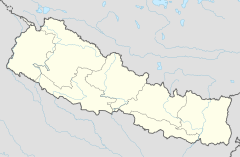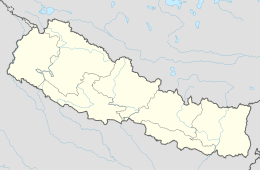Muktinath
| Muktinath Temple | |
|---|---|
 The temple of Muktinath ('lord of liberation or moksha') during winter months | |
| Religion | |
| Affiliation | Hinduism, Buddhism |
| District | Mustang District |
| Deity | Vishnu |
| Features |
|
| Location | |
| Location | Muktinath (Dhawalagiri) |
| Country | Nepal |
Location in Nepal | |
| Geographic coordinates | 28°49′01″N 83°52′18″E / 28.816854°N 83.871742°E |
| Architecture | |
| Type | Pagoda |
| Elevation | 3,762 m (12,343 ft) |
Muktinath is an ancient Vishnu temple located in Mustang, Nepal. The temple of Muktinath, known as 'the lord of liberation', is sacred to both Hindus and Buddhists whom they worship as an abode of Hindu deity Vishnu and Buddhist deity Avalokiteśvara respectively.[1][2][3] Located in the Muktinath valley at the foot of the Thorong La mountain pass, it is one of the world's highest temples at an altitude of 3,800 meters. The temple is given a status of one of the 108 Divya Desams of Hinduism (and the only Divya Desam located outside India) as well as one of the eight most sacred shrines, known as Svayam Vyakta Ksetras, of Vaishnavism.[4] It is also one of the 51 Shakta pithas, associated with the head of goddess Sati. [5] The temple complex is known as Mukti Kshetra, which literally means "the place of liberation (moksha)" and is one of the Char Dham in Nepal.[1]
For Buddhists, Muktinath is an abode of dakinis - goddesses known as Sky Dancers and is considered one of the twenty-four Tantric places. Tibetan Buddhists call it Chumig Gyatsa, which in Tibetan means "Hundred Waters" and the murti is revered as a manifestation of Avalokiteśvara, who embodies the compassion of all Buddhas.[6]
Muktinath temple is seen as a symbol of religious harmony in Nepal where both the Hindus and Buddhists have been historically worshipping on the same spot, mutually respecting and including each other.[7]
Legend
[edit]Muktinath's importance within Hinduism is described in ancient Hindu Vishnu Purana's Gandaki Mahatmya. [8] The ancient name of Muktinath in Sri Vaishnava literature is Tiru Shaligramam. The Gandaki river, which flows downstream from Muktinath, is considered to be the only source of the shaligrama shila, the non-anthropomorphic representation of Vishnu. The Tibetan Buddhist tradition states that Guru Rinpoche, also known as Padmasambhava, the founder of Tibetan Buddhism, meditated at Muktinath on his way to Tibet. [7][9] The temple is believed to have been blessed by numerous mahasiddhas. [2]
Architecture
[edit]The central shrine of Muktinath is considered by Hindu Vaishnavas to be one of the eight most sacred shrines, known as Svayam Vyakta Ksetras. The others are Srirangam, Srimushnam, Tirupati, Naimisharanya, Thotadri, Pushkar, and Badrinath. The murti inside the temple is made of gold and is the size of a man.[10] The prakaram (outer courtyard) has 108 bull faces through which water is poured, called mukti dharas (liberation representing the sacred water from 108 Divya Desams of Hinduism. [11]
Religious significance
[edit]Hinduism
[edit]Vaishnavism
[edit]
Muktinath is sacred to the Sri Vaishnava tradition. The deities of Vishnu and his consorts, Sridevi and Bhudevi, are regarded by adherents as offering jivanmukti to devotees, offering the epithet Muktinath to Vishnu. It is praised by Thirumangai Alvar in the compilation of the Nalayira Divya Prabandham. The river Gandaki, flowing adjacent to the temple has a kind of stone called shaligrama. The different patterns of the stone are worshiped as different forms of Vishnu. The colour white is considered as Vasudeva, black as Vishnu, green as Narayana, blue as Krishna, golden yellow & reddish yellow as Narasimha and Vamana in yellow. The stones are found in various shapes with even shapes of the Panchajanya and the Sudarshana Chakra, the attributes of Vishnu.[12] The temple is revered in Nalayira Divya Prabandham, the 7th–9th century Vaishnava canon, by Kulasekhara Alvar in one hymn. The temple is classified as a Divya Desam, one of the 108 Vishnu temples that are mentioned in the book. Many devotees have contributed to it, most prominently the Alvars. Thirumangai Alvar could not reach Muktinath, but sang 10 pasurams from the nearest place, in praise of the deity. Periyalvar sang in praise of Vishnu as "Salagramamudaiya Nambi".[12]

The pontiff of Srivilliputtur installed the idols of Andal (Gotadevi), Ramanuja, and Manavala Mamunigal there during the yagna performed between 3 and 6 August 2009. This is considered by devotees of the tradition to be a milestone in the history of Muktinath. A large crowd of devotees visits this shrine, where the deity resides in the form of Sri Paramapada Nathan with his divine consorts Sridevi, Bhudevi, Niladevi, and Gotadevi.

Shaktism
[edit]Muktinath Temple is considered an important place of pilgrimage in Shaktism as one of the Shakta pithas associated with goddess Sati's head (face). The Shakti of Muktinath is addressed as "Gandaki Chandi", and the Bhairav (Shiva) as "Chakrapani".[10]
Muktinath temple complex is also revered as a place on earth to host all five elements (fire, water, sky, earth, and air) from which all material things in the universe are made. The goddess Jwala Mai Temple situated adjacent to the Muktinath Temple is worshipped for its sacred flame fueled by natural gas emanating from the earth.[13]
Buddhism
[edit]
The temple has been worshipped by Buddhists as an abode of Avalokiteśvara, the Buddha who embodies the compassion of all Buddhas. In Tibetan Buddhism, the place is known as "Chumig Gyatsa" (the Hundred Springs) and is venerated as one of the important places related to Padmasambhava, the founder of Tibetan Buddhism and one of the 24 Tantric (sacred) places of Tibetan Buddhism. [2] The area of the temple is worshipped as a residence of 21 Tara and many Dakinis, goddesses known as Sky Dancers.[14] [2]
-
Statue of Guru Padmasambhava
-
Buddhist Goddess in Muktinath temple complex
-
Buddhist thangka
The nuns of the temple complex are considered to be female goddesses called Dakinis and to be the offsprings of the females who were taught by Padmasambhava during his stay in Muktinath. It is believed that Padmasambhava built a statue in his own image before departing from Muktinath to Tibet, which resides in the Mharme Lhakhang Gompa and is tended by these nuns.[14]
Gallery
[edit]-
Muktinath valley
-
Muktinath Temple
-
Entrance to the temple area
-
The Vishnu shrine inside Muktinath Temple
-
Goddess Jwala Mata Shakta pitha Temple
-
Muktinath Temple with 2 ponds (right) and 108 spouts (left)
-
Close-up of one of the 108 holy spouts
-
Narendra Modi, Prime Minister of India, offering prayers
-
Temple and pond
-
Prayer flags over Muktinath area
-
Gumba
-
Buddha overlooking valley
See also
[edit]- Narsingh Gompa, a Buddhist monastery nearby
- Bajrayogini Temple
- Guhyeshwari Temple
- Pashupatinath temple, Nepal
- Badrinath
- Kedarnath
- Manasarovar
- Changu Narayan
- Janaki Mandir
- Shree Pashupatinath
- Budhanilkantha Temple, Sleeping Vishnu
References
[edit]- ^ a b "Nepal's Top Pilgrimage and Holy Sites – The Abode of Spirituality". Nepali Sansar. 2019-03-30. Retrieved 2020-12-14.]
- ^ a b c d "Brief history of Muktinath-Chumig Gyatsa at the Annapurna Circuit - Nepal". muktinath.org. Retrieved 2024-06-28.
- ^ "Muktinath Temple". templesofindia.co. 2024-04-13. Retrieved 2024-06-28.
- ^ "Muktinath - A Religious site for Buddhist and Hindu followers". www.buddha-statues.info. Retrieved 2024-11-25.
- ^ Alightindia. "Muktinath Temple - History, information & Temple timings". Muktinath Temple - History, information & Temple timings. Retrieved 2024-06-28.
- ^ Zurick, David (2006). Illustrated Atlas of the Himalayas. Lexington: University Press of Kentucky. p. 153.
- ^ a b "Brief history of Muktinath-Chumig Gyatsa at the Annapurna Circuit - Nepal". muktinath.org. Retrieved 2024-06-28.
- ^ "Gandaki Chandi Homam | Devi Homam |". www.vedicfolks.com. Retrieved 2024-06-29.
- ^ Alightindia. "Muktinath Temple - History, information & Temple timings". Muktinath Temple - History, information & Temple timings. Retrieved 2024-06-28.
- ^ a b "History of Muktianth Temple". Muktinath Temple Tour | Muktinath Temple Package | Muktinath Yatra. Retrieved 2024-06-30.
- ^ "Muktinath Temple: Muktinath Dham History, Muktinath Mandir Dharshan 2022". Divine Kailash. Retrieved 2024-06-30.
- ^ a b R., Dr. Vijayalakshmy (2001). An introduction to religion and Philosophy - Tévarám and Tivviyappirapantam (1st ed.). Chennai: International Institute of Tamil Studies. pp. 489–90.
- ^ Tour, Pilgrimage (2024-01-08). "Places to Visit In and Around Muktinath". Medium. Retrieved 2024-06-30.
- ^ a b "Muktinath: An Exemplar of Religious Symbiosis | Buddhistdoor". www2.buddhistdoor.net. Retrieved 2024-06-30.
Picture in map of nepal



















